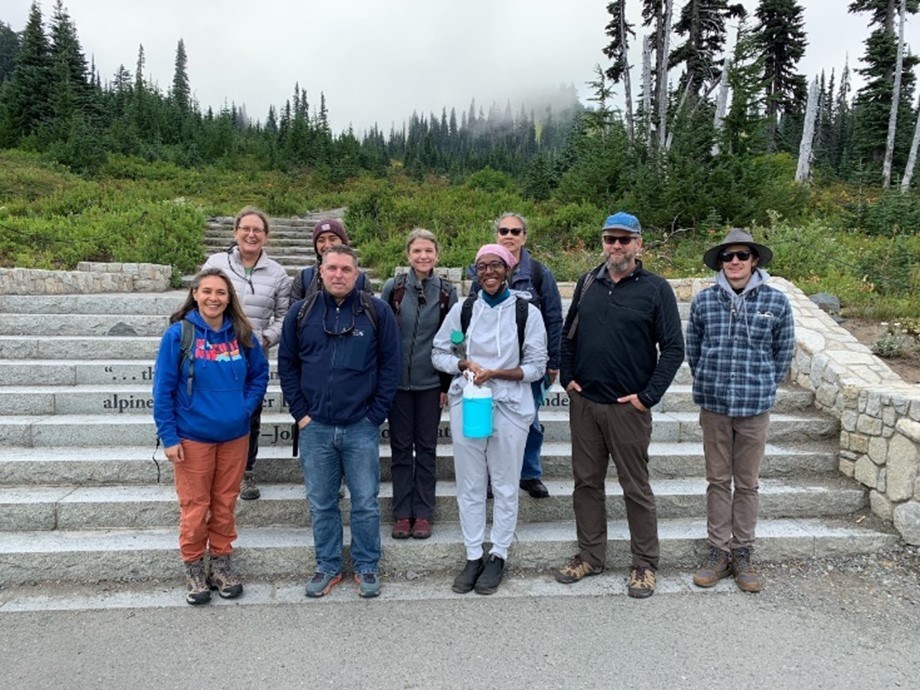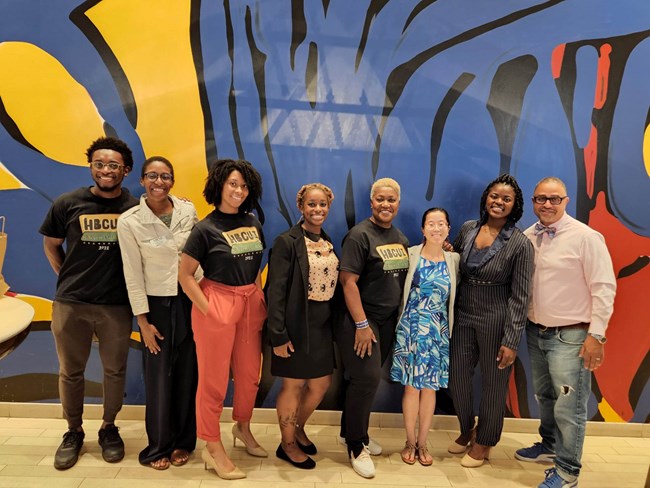Last updated: February 23, 2023
Article
Intern Spotlight: Nina Pulley

NPS Photo
Meet Nina Pulley, who has served as an Interpretive Development intern at Harriet Tubman National Historical Park (HART), a Communications intern for the Denver Service Center (DSC), and currently a Park Planning and Environmental Compliance fellow with the Pacific West Region of the National Park Service (NPS) through the Greening Youth Foundation.
I always had a feeling that I wanted to be a steward of something sacred for the benefit of younger people—from oral histories, to protected forests, or archives. I think that interest eventually led me to the National Park Service. I first interned with the Smithsonian National Museum of African American History and Culture (NMAAHC) in the fall of 2019, the first year after I graduated. The first week I was there, I was assigned to read the volume of the Journal of Public History that documented the many African American institutions that contributed to the founding of the NMAAHC. I became passionate about public history as a right and historic preservation as a discipline. At the end of the internship, I moved to North Carolina in 2020 to care for my late grandfather’s home in the Piedmont region, which gave me two opportunities: finding remote work and experiencing nature in a new way. I was surrounded by the farms, pine forests, and rolling mountains and experienced a new climate and new species – wrens, gray foxes, and whitetail skimmers, just to name a few. I decided to apply for an interpretive development internship with the Harriet Tubman National Historical Park (HART) because it felt meaningful at the time. I was beginning to learn more about the history of the land I was living on as well as the broader histories of enslavement, and at the time, I wanted to continue “remembering” and discovering a fragmented and often-incomplete history.
The highlight has been the sense of mission I have felt at different parts of the journey. At Harriet Tubman National Historical Park (HART), I had the opportunity to learn about Black land ownership and homesteading, both historically and contemporarily, and how to draw out relevant themes from well-worn stories. While working remotely from North Carolina, only a couple of hours from where some of my ancestors had been enslaved, I became really interested in the memories—the pain, the blood, the tears—that the land still holds. This led me to learn more about how these areas might be protected or stewarded between federal management and the community. I also envisioned an on-site community garden with an interpretive program and wanted to learn how it could be implemented. I’ve had the opportunity to think about and witness work that both acknowledges and transcends difficult histories, like the Network to Freedom or Japanese American confinement sites. I think that is ultimately what history sharing aims to accomplish. I think there’s something truly meaningful that can happen when people rediscover the stories we tell each other and ourselves. In my mind, ideally, the National Park Service can be that: a place where people can get an honest, thorough, and informative version of contested or hard-to-access histories. I think maintaining the hope of that has been the highlight of my experience.
How did you find yourself at the National Park Service?
I always had a feeling that I wanted to be a steward of something sacred for the benefit of younger people—from oral histories, to protected forests, or archives. I think that interest eventually led me to the National Park Service. I first interned with the Smithsonian National Museum of African American History and Culture (NMAAHC) in the fall of 2019, the first year after I graduated. The first week I was there, I was assigned to read the volume of the Journal of Public History that documented the many African American institutions that contributed to the founding of the NMAAHC. I became passionate about public history as a right and historic preservation as a discipline. At the end of the internship, I moved to North Carolina in 2020 to care for my late grandfather’s home in the Piedmont region, which gave me two opportunities: finding remote work and experiencing nature in a new way. I was surrounded by the farms, pine forests, and rolling mountains and experienced a new climate and new species – wrens, gray foxes, and whitetail skimmers, just to name a few. I decided to apply for an interpretive development internship with the Harriet Tubman National Historical Park (HART) because it felt meaningful at the time. I was beginning to learn more about the history of the land I was living on as well as the broader histories of enslavement, and at the time, I wanted to continue “remembering” and discovering a fragmented and often-incomplete history.
What has been the highlight of your experience as an intern with the National Park Service?
The highlight has been the sense of mission I have felt at different parts of the journey. At Harriet Tubman National Historical Park (HART), I had the opportunity to learn about Black land ownership and homesteading, both historically and contemporarily, and how to draw out relevant themes from well-worn stories. While working remotely from North Carolina, only a couple of hours from where some of my ancestors had been enslaved, I became really interested in the memories—the pain, the blood, the tears—that the land still holds. This led me to learn more about how these areas might be protected or stewarded between federal management and the community. I also envisioned an on-site community garden with an interpretive program and wanted to learn how it could be implemented. I’ve had the opportunity to think about and witness work that both acknowledges and transcends difficult histories, like the Network to Freedom or Japanese American confinement sites. I think that is ultimately what history sharing aims to accomplish. I think there’s something truly meaningful that can happen when people rediscover the stories we tell each other and ourselves. In my mind, ideally, the National Park Service can be that: a place where people can get an honest, thorough, and informative version of contested or hard-to-access histories. I think maintaining the hope of that has been the highlight of my experience.

NPS Photo
What is it like cultivating community as a National Park Service intern?
I have found that community is about intentionality, good faith, and genuine care, which is really all that is required. I think at first, especially now, there is the idea that you want to find someone from a similar background, which can be validating. However, the people I’ve connected with most have seemingly nothing in common with me except a common belief or motivation or mission. So, I think cultivating community really starts with oneself and understanding where you’re at, where you want to go, who also wants to go, and how to get there.
What projects have you been involved in so far?
My time between planning programs at HART, the Denver Service Center (DSC), and now the Pacific West Regional (PWR) has exposed me to the wide variety of parks, projects, and resources the National Park Service has, which has allowed me to integrate them into a seamless experience. At HART, I researched the Thompson Memorial AME Zion Church, which was the epicenter of Auburn’s emancipated community throughout much of the 19th century. What began as a research paper expanded into discussions on interpretive strategy, the ethics of certain approaches to research, and the responsibilities of stewarding communal histories on a federal level. The experience was intense, immersive, and valuable. Two other projects were forming recommendations for an app in development called Journey to Greatness: Character Lessons from the Past that follows the formative childhood events of four historical figures, including Harriet Tubman. The other was training for Leadership in Energy and Environmental Design (LEED) accreditation and providing recommendations for implementations our park could pursue that would result in LEED credits. The LEED project was in part where the community garden idea came from. I learned Harriet Tubman homesteaded at her residence in Auburn and people of that time would often have a lot of knowledge about different types of plants, including native plants. I wanted to find a way to integrate that history with tangible communal benefit.

NPS Photo
What have you learned that you will take forward in your career?
While at HART, back in 2021, I struggled with the history and the research because much of what Harriet Tubman and others endured was very traumatic. People were moving from enslavement to legal freedom and were regularly the recipients of brutal violence. The research allowed me to understand the richness and the changes of the period and pushed me towards empathy. It gave me a different perspective of my own life, and both the blessings and the challenges of living in the twenty-first century. This is one of the cornerstones of interpretive strategy: making what is otherwise mundane accessible and alive. So, I think my time there helped me to be a better learner, humbler, and a better communicator.
In addition to all the industry-specific things like project management, park planning policy, writing and editing, and infrastructure development, I left with the importance of prioritizing time and values. Time, in that there were so many large-scale, team-led projects happening. There’s always a lot going on, and it’s important to be focused. Values, in that a lot is changing—especially in this season— so it’s important to have a mission and a sense of purpose. In my opinion, values of honesty and goodwill will always stay the same, and it’s important to be guided by those through times of change and through challenges. I think people who have led the way and make meaningful contributions always have them in mind. This is, more than anything, what I hope to take forward with me—a clear sense of values and mission.
Have a question about Youth or Young Adult Programs? Please e-mail us. Learn more about what we do. Be sure to follow us on Facebook, Twitter, and Instagram.
